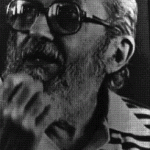Teaching, Technology, and Eckstein Hall
 There is convergence of ideas about teaching and technology around the Law School lately. The Law School is holding idea sessions as part of our strategic planning process. A significant part of the discussion involves teaching: effectiveness, learners, full and part-time education. Earlier this week Douglas Fisher published an article in the Chronicle of Higher Education on “flipping” his database course at Vanderbilt. Flipping a course refers to taking the in-class lecture component and moving it to an online component, usually accomplished by recording the lecture. Earlier this summer I attended a presentation by Professor Norman Garland (Southwestern School of Law) who flipped his Evidence course and reported on the process and results. These threads all come together this week for me.
There is convergence of ideas about teaching and technology around the Law School lately. The Law School is holding idea sessions as part of our strategic planning process. A significant part of the discussion involves teaching: effectiveness, learners, full and part-time education. Earlier this week Douglas Fisher published an article in the Chronicle of Higher Education on “flipping” his database course at Vanderbilt. Flipping a course refers to taking the in-class lecture component and moving it to an online component, usually accomplished by recording the lecture. Earlier this summer I attended a presentation by Professor Norman Garland (Southwestern School of Law) who flipped his Evidence course and reported on the process and results. These threads all come together this week for me.
We haven’t flipped any classes here but we have blended (a term Garland prefers to flipping) a few. Some MULS faculty have been long time adopters of technology both in the classroom and outside. Many have electronic course pages, electronic supplements, electronic casebooks, and even video webcasts of course supplements. Several faculty here have blended some of their traditional in-class instruction with required out-of-class viewing of lectures. The MULS faculty who have blended their classes use the out-of-class lecture to establish the basics of the topic, which means in-class instruction can focus less on establishing the topic and more about exploring its nuances and its applications.

